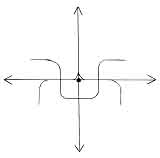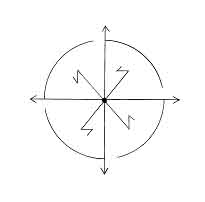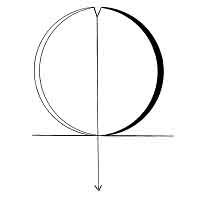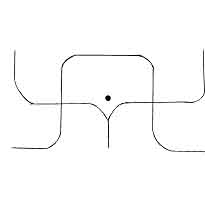Guardians of Darkness
A. A. Vladimirov (USSR, Degree Unknown)
Introduction:
For the majority, it is impossible to imagine that once upon a time there was no concept of absolute “good” and “evil,” and no scapegoat to be accused or blamed for your personal faults or failures. Dualism is a relatively new concept and it's certainly not a form of "advanced thinking" at all, nor is it related to dialectical thinking. Dualism is a form of either stupidity or cognitive disability. (According to A. Crowley, all dualism is klippothic!)
Dualism is a relatively new concept not only in a purely historical perspective, but also in the chronological development of various philosophies and religions - independent of their origins.
There are stages of cyclic progression and elimination for any existing structure, including different schools of thought and even dogmas, that may appear unchangeable for the observer fixed on the perception of a limited period of time. From this standpoint, careful observations along the centuries indicate that Dualism is a hallmark of the rot and decay of teachings that were once thriving and progressive.
As all the events of so-called “spiritual origin” can be explained by the facts, which are earthly and mundane, there is an explanation for Dualism being a clear sign of mental degradation - a degradation of the hierarchy of rulers and priests initially supposed to multiply and preserve the wisdom of their ancestors. But before turning to this point in more detail, let us travel back in time to the period.
Before Dualism Existed:
When Dualism did not exist and polarities were perceived as inseparable attributes of the same natural events (which they, in fact, are), the roots of the future so-called “Dark Side” could be traced in the teachings of practically every existing culture. It is the perception of these roots that was totally different. For example, Loki was respected, if not worshipped. Set, the Lord of the Egyptian town of NBT, was the Warrior in Gold who defeated Apep (also seen as Typhon, a representation of chaotic natural force - eg, typhoon). As much time passed and the centre of political power moved from Southern Egypt (where NBT was located) to Northern, Set was demonised and also associated with the serpent (Typhon) whom he defeated in the earlier myth. Still, he was often gratified and worshipped. Many of the early deities possessed polar characteristics being beneficial for a certain group of people and vengeful for another. Gods of war, such as Wotan, were invoked to kill, crush and destroy and the war itself was accepted as a positive event - as long as it was won. In Egypt, Isis Urania was a bringer of knowledge and a preserver at the first half of human life while the second half was ruled by Isis Xator, the Queen of the Dead and personified destruction. Fifteen avatars of Kali varied from Uma, goddess of medicine and bringer of life, to Dhumavati, goddess of rot, decay, putrefaction and disease. All these attributes were accepted as a whole picture of the Deity in question. It was not a case of "one man's god is another man's devil." It was moreso that a God embodied all aspects of personality viewed as positive and negative, just as any living thing could be seen as friend or foe, nice or not-nice.
There was an element of true elitism in invoking certain aspects of the ancient gods. Only a skilled follower of the Left Hand Path could call the powers of Dhumavati and only a warrior would pray to Durga. Shiva, manifested to the majority as the ultimate destroyer, SadaShiva (“the Black Shiva”), was the teacher (SiddhaShiva) for the few enlightened and empowered by Chaos (See the works of Shankara Acharia for reference).
There is a common misconception that Judaism is inherently dualistic and monotheistic. In the initial Cabalistic tradition there is no absolute “good” and/or “evil,” and there is no “Satan” opposing the divinity. There is Samael, the messenger of Death, snatcher of souls and Supreme Prosecutor who follows the Will of ancient Hebrew GODS (Elohim, plural). The demonisation of Samael is a relatively late event and probably related to Islam more than to Judaism or Christianity.
From the very beginning of Islam, Azrail = Samael is an incarnation of Iblis = Shaitan. This is paralleled philosophically, geographically and temporally by the Yezidi belief that Azrail, The Angel with Thousand Eyes, is an emanation of Melek T’aus. Interestingly, that after the loss of Samael from their “pantheon,” early Gnostic Christians tried to “replace” him by yet another Angel of Death - Ieronimus. However, Ieronimus was also demonised after a short period of time. The fear of Death was and is very strong in those who could not and can not live their lives to the full extent!
It appears that dualisation and demonisation go hand in hand, they come together. Reflections of many past legends and deities can still be found in modern beliefs, including Christianity. But what we find is a pale image of the initial source, inverted and desecrated.
Take a look at the Sumerian mythology - the first legends ever to be recorded. Marduk, the Fire and Chaos Rebel, rises and fights the war against the creators of this world (Tiamat, Absu) who represent Ice, Order and stagnation. Employing magic, he wins and brings knowledge and power to his supporters. Considering that Tiamat is probably a prototype of the future Aramean Leviathan (and is also the same as Apep or Apophis), it may sound confusing that both archetypes (if Marduk is considered a Luciferian prototype) are placed at the same side/pantheon in some forms of modern Satanism.
Everything becomes clear to the non-dualised, healthy mind when one recalls the cyclic interactions, or dialectical interactions, between polarities in nature all around us.
Turning back to the legend mentioned, the Promethean-Luciferian character is present in nearly all mythologies that ever existed and in all “pre-Judean” religions (if we separate early and late Judaism or what one might call “Caballa for the Few” separated from “Judaism affected by Christianity for masses”).
In Greek mythology, even though Prometheus is chained to a rock, he is liberated by Hercules at the End of Times. In Vedanta, Shukra, The Demon of The Morning Star, gains incredible magical power by concentrating on Eternal Fire while hanging above it upside down for the whole millennium. Employing this power, he defeats Brihvaspati, The Supreme Teacher of Gods, a Jovian Archetype who dwells in the illusion of “knowing everything.” The weaklings or dull-minded had inverted “the winning sides,” perhaps, because the internal world of their underdeveloped imagination stood in total opposition to the surrounding objective reality - a reality that they were either too dull or too damaged to understand.
In the process of dualisation and decay, not only the myths, but the pathworking and lifestyles of the followers became perverted. Is it not possible for anyone, who sets up a wrong aim, such as a total victory of a non-existing “good” over a never-existed “evil,” to follow a path that leads to gratification, indulgence and success. All they can do is live in fear, fear of life, fear of death and blame their failures on imaginary devils (or other people that they brand demonic).
Even nowadays, dualised minds often perceive abstinence as a kind of virtue. Even many of the so-called “Tantrics”(usually watered down versions for Western consumption) talk about “Left Hand” and “Right Hand” Path. Nothing of this kind ever existed in the initial Shivaite mythology in the sense that anyone means these terms today. When the Panchatattwa (a collection of sacred Tantric texts, “The Fifth Veda”) tells about liberation of sexual energy, such as in the ritual of “The Sacred Five,” it has a very literal meaning. At the beginning, there is no “Right Hand Tantra” - all psychodramas or yogas performed are inherently “Left.” In the early, undiluted paganism, indulgence and strength through joy are ever-present.
There is an early Vedic legend about the nine old Rishi (saints) who were living a life of worship and complete abstinence in hope to gain both power and mercy of the gods. As the time passed, they became dissatisfied with Shiva living a life of indulgence and so they started criticising the Destroyer for his sexual excesses and giving a “bad” example to his followers. Shiva sent his lieutenants Choka and Neka to tell the annoying Rishi to shut up. The lieutenants returned with the news of disobedience as the Rishi continued badmouthing, confident in their invincibility and protection by other gods. Angered, Shiva sent an army of demons that ripped the Rishi apart limb by limb, chopped their heads off, stuffed the heads into the ritual vessels and urinated on them. Not a single god or goddess lifted a finger to help the dumb saints. Think about this legend. Twice.
If in this case the prototype of future “holy life” led to the destruction of its followers, there are other myths in which the demons, surprisingly for the modern christianised minds, resort to the “holiness and chastity” as means to defeat gods. They always fail. For example in the legend explaining the appearance of Kali: Hiranayakshipu amassed immense magical power by refusing to spend any energy on earthly, fleshly things. This power was sufficient to defeat the pantheon. Then the gods decided to take a risk and summoned Kali, an entity of a totally alien origin from the Outside Darkness - and every god handed her his personal weapon. Hiranayakshipu died a very unpleasant death.
In yet another myth three floating heavenly fortresses populated by the most “pure” rakshas were shot down and smashed into pieces by Shiva. Early Shivaite mythology clearly states that the life of gods is a life of indulgence, knowledge and power, expressed, when necessary, through totally amoral violence.
Returning to the demonisation as a part of a dualistic culture: there is an interesting fact you never hear about. The description of Jehovah in the Old Testament is a description of an average vedic rakshas. If you do not believe in it - pick up the Vedas and the Old Testament and check up for yourself.
The Roots of Evil:
Where did the dualism start? How did certain portions of natural life come to be considered evil? The answer lies in the history of Zervanism (or Zurvanism) - an offshot of the authentic Vedic traditions linked to the slow dissipation of connections between Hindu tribes in their slow “backward” movement from the territory of modern India to the North-West. By itself, Zurvanism is inherently non-dualistic, though some flaws could be seen. The gods of Zurvanism are the demons of the Vedanta: Asuras of Zurvanism (such as Ahura=Asura Mazda) are non-Suras (gods) of Vedas, as in both Sanskrit and Persian the prefix “a” stands for denial. Also compare: “Daeva” in Persian means demon, “Deva” in Sanskrit means god.
As the centuries passed, this initial flaw grew into the corruption of the whole system. The inflexible hierarchy of rulers/priests, chosen by their birth into the “noble” families rather than chosen due to skill and merit, were not able to preserve the knowledge from the masses or educate the masses to the level that they could comprehend. Thus, the inevitable happened, a decay of the “pseudo-aristocracy” combined with the restriction of the free flow of information led to the emergence of Zoroaster's religiohn - the simplified form of Zurvanism for masses - and this was the first dualistic religion on earth.
Obviously, there where those denied the power to decide and judge by “birthright” but capable to do so and to comprehend the philosophy reflecting the objective reality better than those given the pristine authority. The rebellion against the religion of Zoroaster was inevitable.
The legend states that it was a Black Magician named Aztya who founded the movement of Yatukan, also called “nihaniktom duvarisnih” (“those who stalk in great secrecy,” Persian). In Persian Yatu - sorcerer, in Atharva Veda Yatu - sorcery, Yatuvidah - master magician. Yatukih (followers of the Yatukan) were also called Druguvanti (Persian) “The People of the Lie.” Drug/Drudj (Pehlavi) and Draoga (Persian) means Lie, “the word of the snake.” But in Sanskrit the same word (Drogha) means not only “Lie” but also means a “Dragon.”
Apart from the non-dualistic approach and homage to the Forces of Darkness (represented in the archetype of Ahriman), Yatukih employed the spirit of rebellion, asociality, alienation, elitism based on merit, polarity and inversion. They even served what would later be considered "black masses," based upon the inversion of all form and content of the Zoroastrian Initiation Ritual, Var Nirang. Many of the rites practised by the followers of Yatukan involved anti-clockwise movement around the altar stone that symbolised Unity and Non-Duality.
Interestingly, this altar stone was called Setan (meaning “column” or “spine” in Persian). It is possible, that the name “Shaitan” is a derivation of this altar name. Yatukih went as far as challenging the initial concept of Zurvan by developing the magical formulation “Azrvan Akarana,” a combination of Zurvan, the archetype that lies beyond good and evil but still clearly masculine and creative by nature, and Az - primary, chaotic and destructive feminine energy (evolution of the archetype: Az (Persian) = Resh (Aramean) = Lilith/Geh (Hebrew). To illustrate this philosophical concept of Yatukan, I will refer to the unique system of cosmic symbolism developed by Yatukih and demonstrate the significance of some symbols they employed in ritual practice.
The original symbol of Zurvan (see Zurvan picture below) consists of two opposite swastikas linked together and a point between them. The left swastika (anti-clockwise) symbolises The Cycles of Time and presumes that in Zurvanism “The Left Way” was associated with following Nature. The right swastika (clockwise) symbolises individuality. The point in between is the observer/magician who stands beyond the duality. It should be mentioned that in the symbol of Zurvan the observer is rather passive, not connected to both Natural Cycle and individuality. The later fact may signify the roots of the “self-denial” concept - the essence of all "white-light" religions/philosophies - and a clear distortion of the original intent.
Now, let’s take a look at the sign of Azrvan Akarana (see Azrvan Akarana #1 picture). The swastikas changed their polarity: now the “left way” is underlined as self-development and self-gratification while the right anti-clockwise swastika signifies inevitability of the Natural Law and, in some sense, interaction of the individual with the society. The observer/magician is not passive anymore, but intimately linked to the interplay of polarities and expands through exploiting and manipulating them in all directions of life. The arrows of the symmetric cross emanating from the point (the magician) symbolise “healthy conquest and expansion” employing properties of the Four: Will (Fire), Knowledge (Air), Emotion (Water) and Stability/Persistence (Earth). The small triangle formed in the middle by the swastikas and the branches of the expanding cross represents dynamism and evolutionary drive of the individual. The symbol is a whole yet it consists of seemingly opposite elements like left (“I am God”) and right (Lorenzian “Volk is everything, individual is nothing”) swastikas.
Take another look at the symbol. Azrvan Akarana #1. Reminds one of a strange Trident, does it not?
The following picture (see Azrvan Akarana #2 picture) is yet another representation of the sign. In this form, the Self is internalised in the “Cycle of Times and Natural Events” and the lightnings that construct the internal clockwise swastika emphasise the individual power and, at the same time, difficulties and strife in prevailing against the odds, natural resistance on the way of self-development (the “lightning wheel” is more difficult to rotate).
Two celestial objects, namely the Sirius/Dog Star (“Ur Thangh,” the source of the primary, chaotic magical energy) and the Pole Star (“gate” through which energy and souls of the dead, as Yatukih believed in reincarnation but stated that only the highly skilled and evolved can reincarnate, leave the earthly world) played a special role in the cosmology and ritual practice of Yatukan. The symbol of Ur Thangh (see the pic of Ur Thangh) is a fine example of yet another magical sign that crosses the duality and unites the opposites. It is made of two combined, interlinked planetary symbols with the switched half-moon colours:
1. The symbol of Az = Lilith = Black Moon of the modern dualised astrologers. Physical representation: gravitational centre of the Earth. Point rotation cycle 9 years.
2. The symbol of Ashta Vareshta = Selena or the White Moon of the modern dualised astrologers. Physical representation: gravitational centre of the Earth-Moon system. Point rotation cycle 7 years. (Possibly, this Indo-Persian astrological symbolism was the origin of the idea that 7 is a godly number and 9 is the "Satanic" number or traditional number of Esoteric Mysteries. Also, seven is associated later on with God; while 9, the three-fold Muse is associated with Goddess.)
When linked, both symbols form the horizontal line that signifies the limit of our perception. At the same time, the symbols gate the beam of energy (vertical arrow pointed down) from the Great Unknown that empowers the Yatukih magician and leads to earthly success and gratification. Only the one who can combine and explore the significance and cycles of both Az and Ashta Vareshta, thus crossing the barrier of duality while still employing natural polarities, is able to open the Gates of The Dog Star and get the Ur Thangh power. Interesting, that those “modern dualised astrologers” who are keen on the interpretation of fixed stars are still unable to decide if the “influence” of Sirius is good or bad, malevolent or beneficial.
The Ur Thangh symbol is actually three-dimensional with the circle, formed by both half-moons rotating anti-clockwise.
Ironically, the lines of the energy and the limit look like pointed downwards inverted crucifix.
Did the Yatukih survive? As one may expect - no.
Was their knowledge passed to the future generations? As one may expect - yes.
It does not take a lot to establish the direct link between beliefs of Yatukan and teachings of Yezidi. Consider the following points:
1. Both derive from the common geographical zone.
2. The theological approach of both movements is similar. The concept of duality - free, inert and indifferent Absolute (Zurvan/Azrvan Akarana) is common for both teachings. In accordance with Yezidi mythology, all Yezidis are derived from one single Yezid who is identified with the Divine Power itself. And what is this Divine Power? The word Yezid is a combination of words Azed (“God”) and Yazed (“Demon"). Look at the Zurvan and Azrvan Akarana symbols and think. It is obviously striking that both Yatukih and Yezidi ignore the Absolute while paying their respect and homage to the dynamic emanation of this inert absolute that the others consider to be Evil. Compare Angra Manyu/Ahriman and Melek T’aus/Shaitan.
3. There are similarities between ritual practices as well. These similarities include the anti-clockwise movement, the significance of Pole and Dog stars and also Az/Lilith (“the black snake” of Yezidi) for both religions and possible derivation of Shaitan from Setan of Yatukih.
Just as the appearance of the religion of Zoroaster led to the rebellious formation of Yatukan, in the course of history the former also became influenced by the later. There is even some evidence that signs of Yatukan practices may be seen in Zoroastrism-derived Mithraism. Here is the legend that supposedly came into Zoroastrism from Yatukan:
When Ahura Mazda created the hawk, Ahriman created the gorgeous peacock. As in the oversimplified Zoroastrian mythology all “ugly” creatures like toads or snakes are supposed to be evil while all “beautiful” creatures like eagles or stallions are supposed to be good, Ahura Mazda was taken by surprise. “Why did you create something THAT beautiful, o Spirit of Evil?” Ahriman says, “It is because I do what I want and my Path is not restricted by yours.”
Is it possible, that this legend is connected to the future Melek T’aus of Yezidi? Yes, indeed. Also, the connection between some forms of modern Satanism and Yezidi teachings is obvious. We are the carriers of the Black Flame.
DAEVA ANGRO! DAEVA ANGRO! SPENTA MANJU DAITA ORMAZDA!
I acknowledge Alogos Dhu’l-quarnen for putting Yatukan back on the map.
I am grateful to Barbara Livesley for drawing accurate symbols shown here.
Azvran Achrana #1
|
AzvranAchrana #2
|
UR THANGH
|
ZURVAN
|
This essay is dedicated to the memory of my deceased Teacher, Mikhail A. Emelyanov - brilliant Pathologist and Magician (1957 - 1994). Copyright by Andrei A. V. [Original title: Polarity and the origins of Early Satanism. - edited here.]



